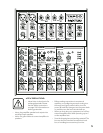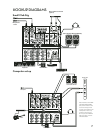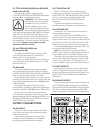
9
UNITY GAIN
The U symbol on most of the
controls, stands for “unity gain,”
meaning there is no change
in signal level. Once you have
adjusted the input signal to line-
level, you can set every control at U, and your signals
will travel through the mixer at optimal levels.
EQUALIZATION
Each EQ control provides up to 15 dB of boost
and cut, with no change to the signal (0 dB) in the
center position. The mic/line channels have EQ
controls on all models. Only the Mix.60 has EQ
controls on the stereo channels.
Although you can bring a sound to life with proper
EQ, you can also mess things up. If you max the EQs
on every channel, you’ll get mix mush, not to mention
driving your mix levels near or beyond clipping. So
equalize subtly; use cut as well as boost.
5. HI EQ
Turning this clockwise boosts the level of all
frequencies above 12 kHz. Turning it counter-
clockwise cuts the levels.
Use this wisely to add sizzle to cymbals or an
overall sense of transparency or edge to keyboards,
vocals, guitar, and bacon frying. Turn it down a little
to reduce sibilance or hide tape hiss.
6. MID EQ (all except
Mix.50)
Turning this clockwise
boosts the level of
frequencies at and around
2.5 kHz. Turning it counter-
clockwise cuts the levels.
The midrange frequencies
include the upper male and
lower female vocal ranges,
and the fundamentals
and harmonics for many
instruments.
7. LOW EQ
Turning this clockwise
boosts the level of all
frequencies below 80 Hz.
Turning it counter-clockwise
cuts the levels.
Frequencies of 80 Hz and
below represent the punch
in bass drums, bass guitar,
fat synth patches, and high-
testosterone male singers.
8. 75Hz Low-Cut Switch
(Mix.100/Mix.120 only)
This switch cuts the bass frequencies below 75 Hz.
We recommend that you use the Low-Cut switch
on every microphone application except kick drum,
bass guitar, bassy synth patches, or recordings of
earthquakes. These aside, there isn’t much down
there that you want to hear, and fi ltering it out makes
the low stuff you do want much more crisp and tasty.
9. +4/–10 Switch (Mix.100/Mix.120 only)
This switch changes the input sensitivity of the
channel to match either the –10 dBv consumer level
or the +4 dBu professional level. Most consumer
equipment with RCA connectors operate at the –10
dBv level, while most professional equipment with
1/4-inch phone jacks or XLR connectors operate at
the +4 dBu level.
As you might expect, the +4 dBu level is higher
(louder) than the –10 dBv level. If you have trouble
getting enough volume from a signal connected to
one of these stereo channels, push in the +4/–10
switch to get more volume.
AUXILIARY (all except Mix.50)
In addition to the main mix output, the mixer
provides an auxiliary mix, which you can send to
parallel eff ects
processors or
stage monitors.
The AUX
SEND knobs
adjust how much
of each channel is
tapped off , added
to the aux mix,
and sent out via
the AUX SEND
(26) jack.
On the stereo
channels, the
AUX knob
controls a mono
sum of the
channel’s stereo
signals. For
instance, on the
Mix.60, channel 3
(L) and 4 (R) mix
together to feed
that channel’s
AUX send knob.
Mix.60 Mono Channel Mix.120 Mono and Stereo Channels
+1
+1
5-15
-15
U
+15
+15
-15
-15
U
EQ
+15
+15
-15
-15
U
HIGH
MID
2.5kH
2.5kH
z
12
12
kH
kH
z
+15
+15
1
AUX
SEND
SEND
+15
+15
U
LEVEL
LOW
80H
80H
z
PEA
PEA
K
PAN
RL
U
5
6
7
10
11
12
4
TAPE
5/6
4
INPU
INPU
T/OUTPU
T/OUTPU
T
IN
IN
OUT
OUT
L
R
CD/TAPE
+15
+15
-15
-15
U
+15
+15
-15
-15
U
+15
+15
-15
-15
U
75H
75H
z
AUX
SEND
SEND
+15
+15
PAN
U
EQ
HIGH
MID
2.5kH
2.5kH
z
12
12
kH
kH
z
LOW
80H
80H
z
AUX
SEND
SEND
+15
+15
BAL
U
+4
+4
-10
-10
RL
PEA
PEA
K
+15
+15
LEVEL
U
RL
PEA
PEA
K
+15
+15
LEVEL
U
8
9
5
6
7
10
11
4
12
12
LOOK
CLOSER


















